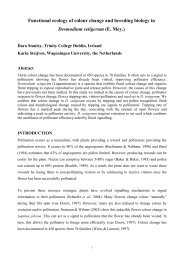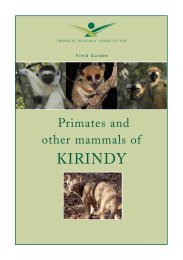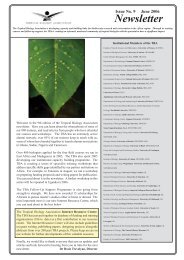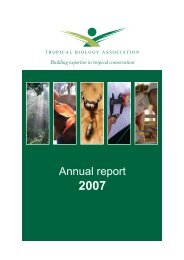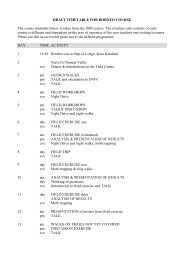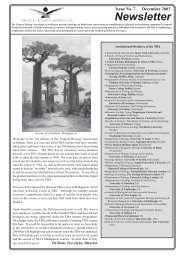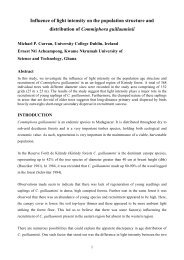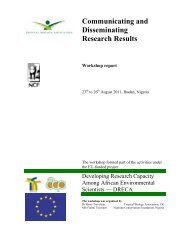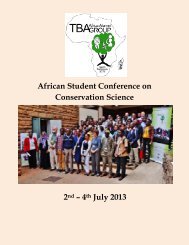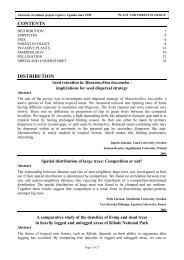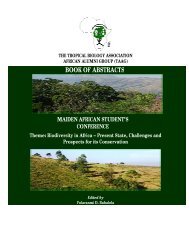Plant and forest ecology - Tropical Biology Association
Plant and forest ecology - Tropical Biology Association
Plant and forest ecology - Tropical Biology Association
Create successful ePaper yourself
Turn your PDF publications into a flip-book with our unique Google optimized e-Paper software.
Abstracts of student project reports: Madagascar courses since 2002<br />
PLANT AND FOREST ECOLOGY<br />
Abstract<br />
Fate of the baobab seed, Adansonia rubrostipa<br />
This study aimed to investigate whether or not the Malagasy giant jumping rat, Hypogeomys<br />
antimena, was involved in the dispersal of one of the endemic Madagascan baobab species,<br />
Adansonia rubrostipa after what was considered its primary disperser - the Archaeolemur - went<br />
extinct with the arrival of humans. Whilst there were no clear results in this respect, observations over<br />
nine days in Kirindy Forest revealed an interaction between H. antimena, Macrotarsomys bastardi<br />
<strong>and</strong> the experimental A. rubrostipa seeds. Novel interactions with Aphaenogaster swammerdami were<br />
also observed, indicating that this ant may be able to carry greater weights than recorded for the<br />
majority of ant species.<br />
Jayaneesh Namah, University of Mauritius, Mauritius<br />
Alex<strong>and</strong>ra Cole, Swansea University, UK<br />
The adaptations of plants in fire-prone ecosystems: savanna <strong>and</strong> dry deciduous<br />
<strong>forest</strong> of Kirindy, Western Madagascar<br />
Abstract<br />
In fire-prone ecosystems we can find particular adaptations of the plants to resist several environmental<br />
stresses <strong>and</strong> first of all the fire. In this study, we documented post-burn re-sprouting response of the<br />
woody plants in a savanna vs. a dry deciduous <strong>forest</strong>. We measured bark thickness in relation to plant<br />
size in <strong>forest</strong>s <strong>and</strong> savanna trees as a key fire survival trait. We found that most of the savanna trees have<br />
relatively thick bark, especially in the juvenile stages, re-sprout vigorously <strong>and</strong> grow tall rapidly postburn.<br />
Forest trees were thin-barked, with high mortality <strong>and</strong> slow regrowth of the few small surviving<br />
plants after a <strong>forest</strong> fire. To underst<strong>and</strong> the origin of savanna we compared the proportion of endemic<br />
plants in both habitats, characterised the soils <strong>and</strong> used other additional bio-indicators. The savanna is of<br />
edaphic origin <strong>and</strong> contains both endemic <strong>and</strong> non-endemic fire-tolerant woody species.<br />
2011<br />
Fetrarimalala R<strong>and</strong>riatsara, University of Anatananarivo, Madagascar<br />
Cristian Trani, University of Trieste, Italy<br />
How does a rare understorey species survive in a dry deciduous <strong>forest</strong> – A case<br />
study on Uncarina le<strong>and</strong>rii in Kirindy Forest, Madagascar<br />
Abstract<br />
In investigating the survival strategies of a little researched rare species of shrub, Uncarina le<strong>and</strong>rii, in a<br />
highly seasonal habitat it was necessary to focus on a number of factors, including: the demographic<br />
distribution <strong>and</strong> dispersion, morphological aspects, phenology, pollination syndrome <strong>and</strong> reward for<br />
pollinators. This study showed that U. le<strong>and</strong>rii is self-incompatible, relying on visitation by bee<br />
pollinators for development of fruits. While the number of inflorescences correlates with plant height<br />
<strong>and</strong> diameter at breast height (DBH), fruit production does not. Nor does it correlate with near<br />
neighbour distances. The demographic survey indicates a normally distributed population within<br />
Kirindy. The spatial distribution shows that while some individuals are found in clumped patches, others<br />
have been dispersed widely in isolation. The above findings suggest that the strategies of this rare plant<br />
are working.<br />
2011<br />
Emmanuel Olabode, University of Ibadan, Nigeria<br />
Sarah O’Loughlin Irwin, National University of Irel<strong>and</strong>, Galway, Irel<strong>and</strong><br />
2011<br />
Page 7 of 11




